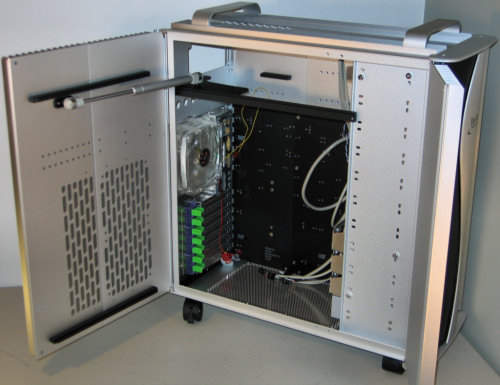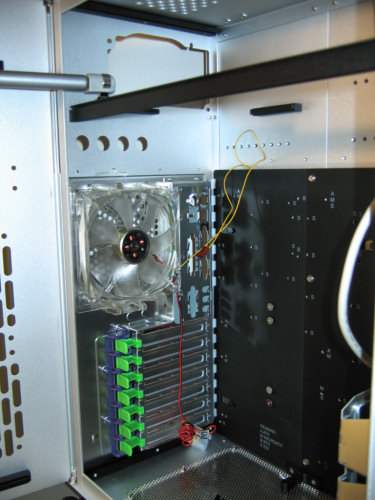Clash of the Titans - TT Tai Chi vs. CM Stacker 830
by Joshua Buss on February 23, 2006 12:05 AM EST- Posted in
- Cases/Cooling/PSUs
Thermaltake Tai Chi (cont’d)
To keep the case as tool-less as possible, Thermaltake simply chose to use thumbscrews to secure drives into the 5¼” bays. While this requires opening the right side of the chassis, there are a couple reasons why this isn't as much of a problem with the Tai Chi as it is with most cases.
First, this area of the case can open entirely on its own as shown in the picture above, which we found that it actually makes for an excellent place to hide additional cables, ensuring tidiness in the rest of the PC. More importantly, however, the Tai Chi's free-turning casters make turning the case a cinch, so access isn't as big of a deal. Two of the same large extended thumbscrews mentioned previously are used to hold this latch secure when closed.
The left side of the case is where the real attraction on the Tai Chi comes though. Here, a hydraulic arm is used to actively swing the oversized access door open, which simply consists of two of the solid passive vent-lined panels connected with the black solid aluminum bars visible in the above picture. The third panel on the left side opens as well, mirroring the panel on the right side that was just discussed.
This active opening mechanism has its own benefits and drawbacks; in using the case, the main advantage to this approach that we've found is that it stays fully open when working inside. Besides that, and the “wow factor“ of showing off the case, there's not much of a reason to incorporate the arm; especially if lots of equipment are installed to the inside of the door, a forceful opening might not be what the user desires. However, if preferred, the entire hydraulic assembly can be removed without hurting any other functionality.
The front of the case is exceptionally accessible, thanks to this dual-door design. Notice how there's another area here between the forward door and the drive bays (about one full inch in width) that could be used for any number of things. This picture is also a decent shot of the bottom mesh and motherboard tray, and also gives one an idea of how neatly they can route the cables from the top-mounted external ports, considering their plentiful length.
Focusing on the inside rear of the case, we find one of the only two main active cooling components, a Thermaltake 120mm blue LED fan. These fans move plenty of air without making enough noise to even really notice that they're on, especially if controlled to use slightly less voltage than the standard 12v.
The punch outs for 3/8” OD water tubing are also visible, as are the same tool-less expansion card locking mechanisms found on the Eclipse, which was recently reviewed by AnandTech. One frustration with this particular scheme is that they can be very difficult to unclip with certain cards. A SoundBlaster Audigy for instance made it darn-near impossible to unclip the green part in our test system due to a bolt on the card as seen here.
We'd prefer here if Thermaltake had simply opted for large thumbscrews like what other manufacturers are doing for the expansion cards. Take comfort though that this is pretty much the only complaint that we have with the Tai Chi after working with it for several days.
The spaces between the PSU area, crossbar, and motherboard assembly are all generous and, combined with the wide-opening dual doors, make working in the case a real pleasure. One last point of interest in this picture is the slots in the motherboard tray near the rear – they're not just at the bottom, indicating yet again that the case is truly designed and ready for BTX motherboards.
To keep the case as tool-less as possible, Thermaltake simply chose to use thumbscrews to secure drives into the 5¼” bays. While this requires opening the right side of the chassis, there are a couple reasons why this isn't as much of a problem with the Tai Chi as it is with most cases.
First, this area of the case can open entirely on its own as shown in the picture above, which we found that it actually makes for an excellent place to hide additional cables, ensuring tidiness in the rest of the PC. More importantly, however, the Tai Chi's free-turning casters make turning the case a cinch, so access isn't as big of a deal. Two of the same large extended thumbscrews mentioned previously are used to hold this latch secure when closed.
The left side of the case is where the real attraction on the Tai Chi comes though. Here, a hydraulic arm is used to actively swing the oversized access door open, which simply consists of two of the solid passive vent-lined panels connected with the black solid aluminum bars visible in the above picture. The third panel on the left side opens as well, mirroring the panel on the right side that was just discussed.
This active opening mechanism has its own benefits and drawbacks; in using the case, the main advantage to this approach that we've found is that it stays fully open when working inside. Besides that, and the “wow factor“ of showing off the case, there's not much of a reason to incorporate the arm; especially if lots of equipment are installed to the inside of the door, a forceful opening might not be what the user desires. However, if preferred, the entire hydraulic assembly can be removed without hurting any other functionality.
The front of the case is exceptionally accessible, thanks to this dual-door design. Notice how there's another area here between the forward door and the drive bays (about one full inch in width) that could be used for any number of things. This picture is also a decent shot of the bottom mesh and motherboard tray, and also gives one an idea of how neatly they can route the cables from the top-mounted external ports, considering their plentiful length.
Focusing on the inside rear of the case, we find one of the only two main active cooling components, a Thermaltake 120mm blue LED fan. These fans move plenty of air without making enough noise to even really notice that they're on, especially if controlled to use slightly less voltage than the standard 12v.
The punch outs for 3/8” OD water tubing are also visible, as are the same tool-less expansion card locking mechanisms found on the Eclipse, which was recently reviewed by AnandTech. One frustration with this particular scheme is that they can be very difficult to unclip with certain cards. A SoundBlaster Audigy for instance made it darn-near impossible to unclip the green part in our test system due to a bolt on the card as seen here.
We'd prefer here if Thermaltake had simply opted for large thumbscrews like what other manufacturers are doing for the expansion cards. Take comfort though that this is pretty much the only complaint that we have with the Tai Chi after working with it for several days.
The spaces between the PSU area, crossbar, and motherboard assembly are all generous and, combined with the wide-opening dual doors, make working in the case a real pleasure. One last point of interest in this picture is the slots in the motherboard tray near the rear – they're not just at the bottom, indicating yet again that the case is truly designed and ready for BTX motherboards.
















55 Comments
View All Comments
JoshuaBuss - Thursday, February 23, 2006 - link
What about direct links to images? Does that work?http://images.anandtech.com/reviews/cases/roundups...">http://images.anandtech.com/reviews/cases/roundups...
Jojo7 - Thursday, February 23, 2006 - link
No.JoshuaBuss - Thursday, February 23, 2006 - link
Try a refresh. Sometimes the image server gets a bit bogged down.latino666 - Thursday, February 23, 2006 - link
Still can't get crap. I notice this problem also with the newegg article too. Man oh man did I want to see those pics.ATWindsor - Thursday, February 23, 2006 - link
The tai-chi has gigantic heat-sinks on the side, but to me they seem like little more then a gimmick. Almost nothing is in physical contact with them, and when they are only taking heat fom air, they seem to be virtually useless. I bet the diffrences if one had a "standard" side would be hardly measurable.The CM 830 surly is more ugly than the old model IMHO, It doesn't quit have that "large clean beast"-feeling anymore.
Cygni - Thursday, February 23, 2006 - link
It seems they were going for the look of the Zalman completly fanless case, but didnt bother to install the flush mount PSU or heatpipes that ran into the doors, haha. :p Oh well.Tamale - Thursday, February 23, 2006 - link
I'd call it a 'large techno beast' now ;)Howard - Thursday, February 23, 2006 - link
The 3/8" holes in the Tai Chi can easily be bored out with a twist drill bit (the regular ones) in a cordless drill. At least, they would be if the material is aluminum, and I think it is.JoshuaBuss - Thursday, February 23, 2006 - link
Yah, but it's still much easier when it can be taken apart and pieces can be worked on individually.Googer - Thursday, February 23, 2006 - link
Could you invert the motherboard on the CM Stacker by installing the tray on the left side in place of the usual right side? If you could possibly allow for better CPU cooling sine the processor would be sitting on the bottome getting plenty of cool air and allowing hot exhaust to escape upwards.